Peony progress, embroidery lessons
I’m still chugging along with the peony. I’m done with the flower, and am now working on the leaves:
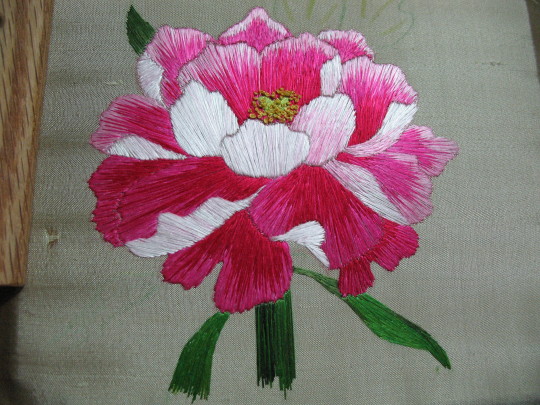
Overall, I’m fairly pleased with how it’s going. I’ve certainly learned a lot – and I’m just working forward, leaving the artifacts of my learning process.
I’ve also started taking lessons. It’s a fairly informal situation, with embroideress Elizabeth LaFleur. She studied silk work at the Embroidery Institute in Souzhou, China, and knows a lot of the Chinese methods for dealing with filament silk. She’s taught me a lot already in just a couple of lessons. Some of them were things I never would have thought of; others are ways to fix difficulties that had been frustrating me but I didn’t comprehend how to overcome.
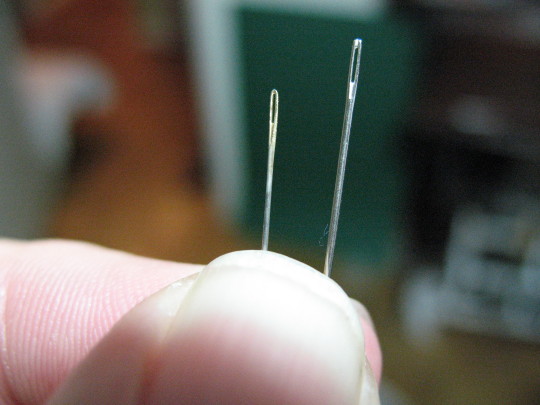
On the left, with the gold eye, is the Chinese needle – it’s amazingly fine. On the right is a #10 embroidery needle that I got from Tanja Berlin; they are not all that much different in size of eye, but the size of the needle shank itself is considerably different. The tiny fine needles make less traumatic holes in the silk ground of the embroidery, allowing me to get crisp, close stitch placement. They’re also a bugger to thread.
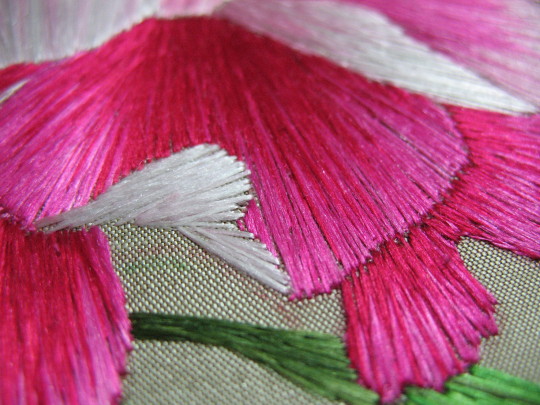
This is a section that I had worked before I started studying with Elizabeth. Particular problems are the ragged edges and the incomplete coverage. I didn’t even notice before how much ground fabric was showing through.
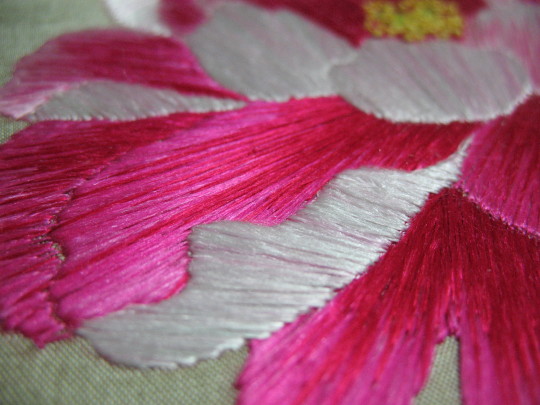
This section (and particularly the turnback) I worked since then – I’m getting much nicer edges, better progression between parts of the design, and more even coverage.
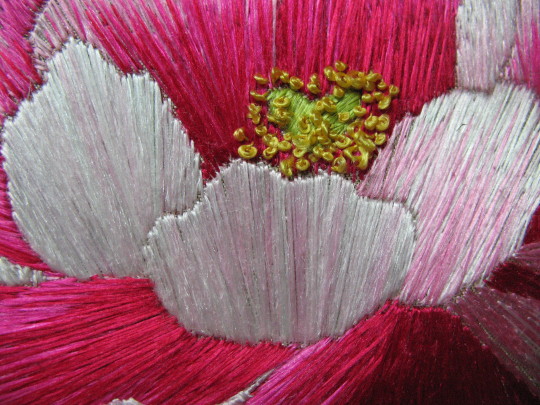
Just another picture. The stuff I worked most recently is in the left and mid-left part of the picture.
In the original, it looks like the French knots are more open – but I fought it for a while, and ended up just accepting the look that the silk wanted to have. I think they look good, just not quite like the picture.

What are the dimensions of this project?
The stretcher frame is 8″ square; the stitched part is bigger than the palm of my hand, but not as big as the palm plus the fingers.
How are you threading the needle? Have you tried the “roll between your thumb” method of threading, like you do for beading thread/needles? It is a great way to get thread that looks too thick into a fine eyed needle…hold the thread end up between your index finger and thumb, just at the end, with none or very, very little of the thread showing. Place the needle, eye down, on top of the place where the thread is, and squeeze and roll your thumb and finger, forcing the thread into the eye. I imagine this will make sense to you, and you probably know the trick, but if you don’t, it is well worth learning. It takes a little practice, but should help you get that thread through those fine eyes. I’ve been amazed at what I can thread using this technique!
And, of course, as always, your work is beautiful. How cool for you that you found a teacher to give you all those new tricks and techniques – that’s always so much fun! Good luck with the threading.
Did you get the Chinese needle from Ms. LaFleur, or do you know a place to buy them online?
Your project is beautiful.
Yup…. that technique totally fails with this, because the eye is so flat. Licking the thread and flattening it between the fingers, THEN trimming with very sharp scissors, makes a thread that goes through easier with this kind.
I actually did find an Ultra Fine Needle Threader that works – but even with glasses on, it’s tough to see the teensy eye very well.
Just stunning.
I got them from her. I only got three, and I had one bent within a day or so – because they’re so fine, they’re easy to bend out of shape. I mostly flattened the bends with needlenose pliers, but they’re never quite the same.
She did say that she found an Ebay seller who’s selling the right kind of thread, and wrote to ask her to send some needles… I asked her to piggy-back some onto the order for me. She said they’re amazingly cheap there, but getting them HERE is tough. I did find that Short Beading needles were very similar in shape and size, although not quite as rounded in the head.
wow, its really beautiful.
and I’m totally jealous of your nice nails!
I imagine you know this as well, but have you tried both sides of the eye? As long as I had threaded needles, I never noticed that the sides were different until I was learning that technique years ago…
But I know how pesky silk can be, and I’m glad you’ve figured something out, anyway. It’s certainly worth the effort!
I don’t think you are as old as I am, but damn these pesky eyes! Threading needles has become harder and harder, even with readers, but Ott lights help, of course, and sharp scissors, as you said. The joys of handwork, and all that goes with it, is worth the bother.
Oh, gosh, that’s pretty. My grandmother had a backyard full of peonies. I looked forward to clipping an armful when they came into bloom. Yours looks like one of the varieties she had. The sheen of the silk must be incredible IRL.
I do needlework. The detail is enviable. Silk thread, smooth long stitches and those little needles would drive my middle-aged eyes crazy! Even with my magnifying glasses for detail work! I hate French knots. It’s hard to get them to look the way one wants.
I can’t wait to see the finished piece.
i love you.
i love everything about you.
Hehe, aren’t his hands always so pretty? I imagine that’s a side effect of keeping them super-smooth for the silk.
Great progress
Hi Michael. I can see the progress you are making, wow you are learning fast. I really struggled to make the edges neat when I began, it is something I am still working on but it made so much difference when someone told me ‘how’ to do it. I love the macro facility on the camera, but my uneven edges is another thing that shows up too well in the close up shots!
This is looking lovely.
CA
Wow….those are some deep, gorgeous colors. Bravo 🙂
I’ve just hit the “time for reading glasses” point. I can read most books and the computer just fine… but for stuff where I need to be able to focus on it really close up, it just won’t resolve. So, I went to the drugstore and got reading glasses. I do plan to go get my eyes checked, but so far, this fixes any difficulty I’ve had.
I did try both sides – from what I can SEE, they’re the same, but they’re so tiny, it’s hard to tell.
That’s beautiful – one of your best I think.
BEAUTIFUL! Absolutely gorgeous!
Would these be easy to find in Korea? I know two people who are there and coming back here soon.
I really don’t know! Elizabeth said that when she was in China, they were about a dollar for a pack of twenty. I don’t know if the Koreans use the same thing – I know the Japanese ones are very different. If your friend finds some, I’d be more than happy to pay for a couple of packs!
wow, beautiful. The blending of the colors is absolutely gorgeous.
peonies
they are amazing!!! The colors and even before you got the extra instruction, were absolutely breathtaking…I am in awe of such talent
Just amazing, as always! you are so talented!
Yep – I can see the differences – although only coz you told me they were there and I was looking for them! But yes – more even edges and coverage.
It’s just gorgeous! You mentioned once that you might give it to your mum, but you weren’t sure (I hope I remember that correctly). If so, she’s a lucky lady!
I was going to do some muttering about the needles but I see that you’ve already had a chat about them in the comments. The only intelligent thing I could say is “ow, so small!. What a complete bugger to thread”. I’m not surprised you bent one! I use #10 sharps and I bend those!
I think it’s cool that I finished the panels for my book, and you finished your poppy at the same time (give or take a day) 🙂 🙂
OK – so it’s a peony not a poppy and you haven’t finished – you are working on the leaves.
I just went to look at the leaves, coz I wanted to see how you’d done them. It’d be a change doing them after all the wedge shaped poppies,I bet! Lots of ‘how long to make the stitches” type decisions?
:chuckle: Oh, I’ve still got quite a bit of road to cover… there are two leaves on the top right, and a green sepal (?) on the bottom left. But, I can SEE the end from here!
If you are interested, I scanned a page on “botanical and anatomical terms of a flower” at
http://elmsleyrose.blogspot.com/2007/12/embroidered-book-cover-small-element.html
so you can check if it’s an er,sepal, or not. If you care! *grin*
Oh, I know what a sepal IS… I just wasn’t sure what piece of green it was. Looking at it, pretty sure it’s a sepal – but could be a chunk of leaf.
I was majoring in Biology (focusing on botany) before I switched gears and got my BA in English Lit!
I want to ask a favour/question of you.
once you had a photo of a moth in your journal. that thing was breathtaking. it looked like a brass brooch or tie clip… i remember the mental game of trying to understand what i was looking and the inner GASP when i realized it was a bug. i love bugs. infinity.
and i linked that photo and your journal in mine that day and you picked up a couple of my friends (polanegri and scootersboy, probably) as a result.
i would like to see that person, that magnificent mothperson but i can’t recall … it’s years and close to an anniversary of years because i came across it not long ago.
do you know what in hell i’m talking about?
Hmm… there are so many different moths!
Maybe it’s the China Tussah moth:
http://www.wormspit.com/pernyi.htm
or maybe it’s the Japanese Tensan moth?
http://www.wormspit.com/yamamai.htm
Photos of the adult moths are down at the bottom of the pages…
If it’s not one of those, can you describe a little more what it looks like, maybe?
i think this is right!
thank you.
the japanese dude!
thank you!
Sure thang!
ear burning?
i was gushing about you today.
Re: ear burning?
:chuckle: You’re too sweet to me!
oh! *grins*
Lovely peony
Well this is looking good. I was just wondering the other day how you were getting on with this. Glad you found some needles that worked.
One of my stitching friends (Denise) has recently qualified to teach Japanese embroidery and she was reporting a conversation she’d had with one of the tutors from the Japanese Embroidery Center during her teachers class. She (the tutor) said that they don’t look for perfect stitching, they look for improvement between one piece and the next. Think this piece qualifies, you can definitely see the improvement as time is going on.
Congratulations.
Did she tell you who the ebay seller was?
I’ve been using either beading needles or very small betweens. One of the beading needles is bent into a curve- I haven’t tried straightening it and it seems to work okay- so long as it’s turned the right way!
I think she said it was OrientalCultures:
http://crafts.search.ebay.com/silk-thread_Crafts_W0QQcatrefZC12QQdfspZ1QQfromZR10QQftrtZ1QQftrvZ1QQsabfmtsZ1QQsacatZ14339QQsaobfmtsZinsifQQsassZorientalcultures
You have to narrow the search with “silk thread” – it’s a huge shop.
The needles aren’t listed, though – she said it was a special request type thing that she asked them to get her a few packs. I’m hoping they come soon!
Is the needle the big difference?
Is it just the slimmer needle that is helping the thread lie better (provide more coverage)? Or are you using a laying tool? Are there other tricks?
I’m using flat silk for both an Opus Anglicanum piece and tent stitch on a sweet bag, and suspect I’m not fully exploiting the possibilities of the silk.
Seeing your examples are wonderful inspiration, and I friended you to continue seeing the progress. I took a drawing class from you in Caid several years ago, and just found your blog through another friend.
Re: Is the needle the big difference?
The needle makes a big difference. It helps in being able to get the thread in JUST the right place – although most of that is a matter of judgment and training the eye and hand. The main thing that it does, is lessen the wear and damage on the thread – when I’m stitching with a length of the flat silk, I usually work with a fairly short section because it will shred after a certain number of stitches.
I don’t often use a laying tool, although I will occasionally use the scissors like one (or grab something handy – an African porcupine quill is also favorite) if the silk is misbehaving. It’s all my hand-reeled silk, so it can occasionally be a little inconsistent. By the same token, however, I have very little hesitation about knocking it around when needed! The difference between a piece of silk lying flat, and one lying with a twist, is huge in these long stitches – there are plenty of twisted stitches on the peony, but usually when I saw them, I would cover them up, so they’re no longer visible.
There are indeed other tricks, but I don’t know if they’ll apply to your Opus Anglicanum. I want to talk with Elizabeth and see if it’s OK if I photograph some of them and put them in my blog – I don’t want to step on her toes information wise.
What kind of system do you use for tension? I need VERY high tension, and Elizabeth taught me to put chopsticks (or, I had these perfect little cardboard spools) under the fabric edge, after I already had it “drum tight” – it’s like changing to a totally different drum, and the stitching changes quite a bit. It’s almost like stitching on metal, it’s so tight. This doesn’t always help, though, if your finished piece will be soft (instead of framed).
Re: Is the needle the big difference?
Tension is a problem — I have a layer of linen atop a layer of muslin, and the whole tacked to stretcher bars. I pulled it tight to begin with, but it seems like I am always removing a tack and repositioning it to get more tension. And in one interior area, there is some rippling (ack!) that simply won’t go away. I’m hoping the underside couching will help absorb the looser fabric somehow.
The design has a square boundary box of silk stitching, and rather than starting stitching from the center outwards, I have been stitching areas as the color strikes me. Which means that the boundary is nearly done.
I have been putting the maintenance of square angles on the boundary at a higher priority than keeping the fabric drum tight. But I have been retensioning as I work, because things stretch. I like the idea of adding the shims, and will try that. Thank you!
Re: Is the needle the big difference?
ah, gotcha! It sounds like the shims might help with the rippling – they sure helped mine!
With a previous piece, I found that holding the piece over a steaming tea kettle while I stretched it, helped – and settled down the stitches considerably at the same time. I didn’t let it get wet, or even damp – just humid.
Mine has some seriously long stitches – on some of the wide petals, as much as an inch and a half – and that stuff just doesn’t lie nicely without a LOT of tension. I’m hoping to find some method to frame it under high tension; right now, when I take it off the frame, the embroidery relaxes and the threads wave. I’ve seen the exact same wave on historical pieces, but it’s not something I want if I can help it.
Re: Is the needle the big difference?
Thank you! So i will be looking for thinner needles (I bet milliner’s needles might be better than what I have been using), adding shims, and restretching next time I brew some tea.
Thanks a bunch!
Re: Is the needle the big difference?
The closest to the Chinese needles that I’ve found at the sewing/crafts stores, are Short Beading needles – they’re still not quite as nice, but they’re very similar in shape and size.
Re: Is the needle the big difference?
Oh – and if you DO find the really, really tiny needles – there is an Ultra Fine Needle Threader (much thinner wire than the usual kind) that will work on them. They’re really a bugger to thread.
thanks! She has yummy colors of silk floss, but the shippings a real killer. And the old textiles are wonderful to look at.. and get inspired by..
I think the shipping probably props up the cost of the items…. if you’re getting 7 sixty-meter skeins of embroidery floss for $.99, there’s got to be something else making their money.
And some of their old stuff is neat – but I wish I could find the really fine-work Miao stuff – the stuff they have in this shop is very different. I own one small piece, I really don’t need more – just to look at.